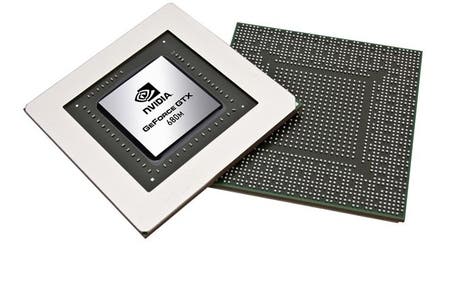GeForce GTX 680M Review
Can NVIDIA's top-of-the-line laptop GPU out-muscle AMD's powerhouse 7970M?
One of the industry's most esteemed desktop graphics cards, the GTX 680, has at last received laptop equivalent, using the very same 28nm Kepler architecture. While NVIDIA currently holds the crown in the high-end GPU space, it's no secret that arch-rival AMD continues to pose a strong presence in the laptop scene. This has largely been thanks to its brilliance in reducing the chipset cost, power rating, and heat output in its leading Pitcairn series, and as result, the Radeon HD 7970M ranks as the best mobile graphics card we've reviewed so far. Months later, and at around £270 dearer, can we expect the GTX 680M to finally knock it off its perch?
Before we go marching into benchmark territory, let's take a look at the kind of heat this cut-back card is packing. Here, we're basically looking at a derivative of the desktop GTX 670, where the 915MHz core clock and 6000MHz memory clock have been pared back to 720MHz and 3600MHz respectively. In particular, this 21% drop in core frequency has huge implications for power usage, and by extension heat, where the draw is now rated at just 100w TDP (thermal design power). This is a sweet spot for higher-end cards in this field, and is one also shared by the 7970M.
Sadly, because ventilation options in laptops tend to be more restrictive than desktops, there's a lack of any bespoke GPU Boost feature in this version. This is a much welcomed feature in desktop Kepler cards, dynamically boosting the clock up to 980MHz if temperatures remain low enough - an official overclock if you will, should the thermal overhead permit. But judging by the high velocity of the fans inside our test Alienware laptop once the card kicks into action, it's clear a ceiling has been reached in terms of thermal output during most games.
Beyond this, the GTX 680M compares favourably to its desktop cousin. It offers a matching 1344 CUDA cores, 32 ROPS, and 2GB of GDDR5 memory, and complies to the PCIe 3.0 standard. To back this up, the memory interfaces through a similar 256-bit bus. The problem here is that the aforementioned cut to its memory clock results in the bandwidth plummeting down from 192.2GBps to just 115.2GBps. This affects the performance of the card at higher resolutions, or when multi-sample-based anti-aliasing is engaged. That said, this does better suit the resolutions an average laptop LCD might operate at, with anything above 1920x1080 being uncommon at the moment.
To put this into perspective, AMD's 7970M still offers a much higher memory clock at 4800MHz (effective), making for a more flexible 153.6GBps overall throughput. Astoundingly, these are identical numbers to the HD 7870 desktop card that it's based on, though the core clock did inevitably need to be downgraded from 1000MHz to 850 to stay viable as a portable GPU. Still, in terms of raw stats, these figures trump NVIDIA's latest mobile release - a surprise considering how much cheaper it is in its commercial release.
It's worth pointing out that like so many cards during their launch windows, there have been some teething problems with the drivers for the GTX 680M. In our case with version 302.74, we found we could run neither the Metro 2033 benchmark, nor change the graphical settings in Crysis 2 without having the screen lock up on us entirely. Fortunately, NVIDIA came to the rescue with patch 306.23 earlier this week, which completely resolves both of these issues for us, plus provides an additional five per cent boost in performance to synthetic tests. Crisis averted! However, we were surprised that we had any such issues at all bearing in mind how close this graphics core is to an established desktop equivalent and we can't help but wonder if further optimisation work could improve performance from this new laptop part down the road.
GTX 680M: Performance Analysis
It's with these fresh drivers that we take on the synthetic benchmarks. These are rudimentary stress tests designed to show off each card's relative strengths, and in the case of 3DMark 11, we made DirectX 11's advanced shaders and tessellated environments the centre of attention. To keep our test methodology on task, we make sure to run both the GTX 680M and HD 7970M on laptops with matching CPUs - an i7-3610QM clocked at 2.3GHz in either case. We also have each equipped with 8GB of 1600MHz DDR3, and ensure all games and benchmarks execute directly from their included SSDs.
Perhaps as a sign of things to come, results are already very mixed between the two. The Metro 2033 benchmark shows us some advanced physics, fire effects, and lighting as we fly through a warzone, with the results averaging out three separate passes. The game is running at a full 1920x1080 resolution with 4x MSAA, 4x anisotropic filtering, depth-of-field enabled, and with very high quality settings selected overall. It's a lead for AMD at just under 2FPS, which is a surprise given the chasm in performance in the other three tests, and suggests the core clock on the 680M may be the bottleneck by comparison.
"Initial benchmarks suggest a decisive victory for NVIDIA in three out of the four tests, but it's fair to say that this is not reflected across the run of play in our gameplay performance analysis."
| GTX 680M | HD 7970M | |
|---|---|---|
| Metro 2033 Average FPS | 20.67 | 22.39 |
| Batman AC Average FPS | 51.00 | 31.00 |
| 3DMark 11 Score | X2099/P6172 | X1808/P5780 |
| 3D Mark 11 Graphics | 1907/6067 | 1636/5556 |
The same logic doesn't hold true for Batman: Arkham Asylum. There's a wide gap in results here, showing NVIDIA's card with a whopping 40 per cent lead in overall frames per second over the 7970M. The settings are much the same as our Metro 2033 tests, with DirectX 11 features enabled, and high settings all round - though in this case we crank up the MSAA to a maximum 8x to really stretch fill-rate. Superior driver support for Unreal Engine 3 titles may be accountable for part of the difference in this case, and the advantage puts 60FPS playback in view for actual gameplay with these settings.
To a lesser extent, this lead is also shown in 3DMark 11's scores. Running Futuremark's software on extreme settings has every test rendering out at 1920x1080, at first taking us across ocean sea-beds to illustrate strengths in processing multiple shader effects. The second test allows us see each card's handling of tessellated geometry, during a sweep around a forest environment. Once again, it's a sizeable lead for the 680M, with around 16 per cent increase over the rival card on this higher setting for both the total and separate graphics scores. The presence of 1344 CUDA cores, as opposed to the 1120 shader units on AMD's card, greatly benefits the first graphics test in particular, where water shaders are a major fixture.
Gameplay Analysis: Video Benchmarks
Of course, these are only broad indications of what each card is capable of. In the end, optimisations are often made behind-the-scenes for scripted benchmarks, which don't necessarily translate in practice for many titles. By necessity, this means our next step is to put both cards into action with analysis of matching gameplay clips, with current favourites like Crysis 2, Battlefield 3, and The Elder Scroll 5: Skyrim under the magnifying glass once more.
"Both laptop GPUs provide stunning mobile performance, but it's clear that there is no overall winner here - a problems for NVIDIA, with its considerably more expensive product."
We're sticklers for pushing for 60 frames per second where possible, and we're glad to say this is entirely within the realms of possibility for each of these three games with these two GPUs. To start, we look at Crytek's latest running at extreme graphical preset, with v-sync enabled, DirectX 11 checked and high resolution textures installed. Extreme is just one step down from the ultra setting, and we find running at our target frame-rate is far more consistent and playable as a result. To the naked eye, motion blur and shader quality remain very similar to maximum settings, and at 1920x1080, the sacrifice to higher grade AA isn't quite as noticeable.
Put side-by-side, the 680M and 7970M are in very close contention here. In fact, this is the tightest match-up we've seen since we started doing GPU tests; both cards show clear and sustained leads in performance at different junctures, and where they meet in the middle, they're very close. For example, the opening submarine sequence gives us a demonstration of how multiple, high-poly characters sharing screen-space appear to favour the AMD card. The divide is by no more than 6FPS as a general rule though, with the readings for each card staying equidistant during this scene.
Meanwhile, performance can greatly favour the 680M during shoot-outs, as shown at the end of the video benchmark. Where long views over the guarded New York streets are concerned, it's the green card that can often take charge - particularly where explosive effects are involved. It's interchangeable, but at one point we see the 7970M drop by as much as 10FPS in a like-for-like situation.
"Based on specs and performance of equivalent desktop parts, NVIDIA should command a substantial lead, but Battlefield 3 is the only game where we saw a clear win with the GTX 680M."
To follow up, we look to DICE's game for another example of how DX11 can be leveraged onto mobile platforms. This FPS is fortunately well optimised for the quad core CPUs in each laptop, where multi-threading is natively supported, meaning bottle-necks from other components shouldn't be a factor here. Again, running at ultra settings proves to be just a bit too much for either card when targeting 60FPS, but we can certainly get away with the lesser high setting, where MSAA is excluded. This test runs with v-sync engaged, and at a full 1920x1080.
The result? Gone is the uncertainty over who's top dog; the 680M reigns supreme in most situations, be it the slow walk through the military camp at the start of the Operation Swordbreaker level, or the concrete-shattering finale on the war-torn streets. The margin for comparable situations may only be by around 2FPS, but it's a consistent one at least for the duration of our tests, and one that also lasts out during most gameplay sequences. The major exception to this rule is the shoot-out in the parking lot, where we see an initial gap of 6FPS at most. This begs the question as to whether it's actually worth the added expense of NVIDIA's card for just a few extra frames.
To consolidate a verdict, we put each card's handling of DirectX 9 to the test with Bethesda's frosty fantasy RPG, Skyrim. In this case, we can finally ramp up the settings to maximum without any troubles; it's ultra all the way with 1080p selected, which also happens to include 8x MSAA.
"Skyrim demonstrates both cards sustaining 60FPS at ultra settings for extended durations but here it's the 7970M that pulls ahead - albeit marginally."
As it happens, Skyrim gives us the closest results yet. It's 60FPS for most of the journey through Helgen village itself, but the downhill route keeps perfection at bay with some wavering 50FPS feedback on both cards. They overlap constantly at these points, dove-tailing up and down. It's difficult to distinguish any commonality here, but certainly for the first third of the route we see the 7970M stick it out at the 60Hz ceiling, while the 680M drops several frames frames under far more frequently. It's an AMD win here, but only by a cat's whisker.
GeForce GTX 680M vs. Radeon HD 7970M: The Digital Foundry Verdict
"This is all about the games, and playing titles like Skyrim or Crysis 2 paints a very different picture to the benchmarks. The gap in performance is so marginal, it seems an excess to fork out the £270 more for the NVIDIA card."
Overall, the duel between NVIDIA's GTX 680M and AMD's 7970M remains the closest match-up we've yet seen in the mobile space. Both laptops deliver stellar results that eclipse most desktop setups - though at the premium prices each laptop is being sold for, you'd certainly hope so. On paper, the AMD offering has a lead in many areas, including the crucial core and memory clocks, while the NVIDIA card is notable for having an excess of CUDA cores in its favour. However, the benchmarks show a hefty lead for the 680M, particularly with the Unreal Engine 3-driven Arkham City. It's only Metro 2033 that ends up going in AMD's favour here.
This is partly to be expected given the origin of the cards, where pitting their desktop forerunners, the GTX 670 and HD 7870, against each other would produce a far wider margin in favour of the former. Ultimately, it's a testament to how well each company has tailored the Kepler and GCN architectures to suit the needs of laptop users. The power overhead remains equal at 100w TDP in either case, and as a by-product, the noisy ventilation needed to keep either card ticking reveals how far each GPU is being pushed. There's very little overhead to use here for overclockers, and even the GPU Boost feature seen in other Kepler cards has been sadly omitted from the mobile versions.
But this is all about the games, and playing titles like Skyrim or Crysis 2 paints a very different picture to the benchmarks. The gap in performance is so marginal in practise, it seems an excess to fork out the £270 more for the NVIDIA card, if the current crop of top-end games are to go by. The AMD card has slight advantages in spots during Crysis 2, with much of the rest being a close tie. The only mentionable lead from the 680M comes during Battlefield 3's battle scenes, but this still isn't as wild as the initial benchmarks might suggest.
It's possible the drivers for the 7970M card have had more time to mature since its May release, and in the coming weeks and months we may see software tweaks from NVIDIA to further distinguish the two. Regardless, the good news is that both cards are ultimately very close contenders for the same high-end position. However, we can't ignore the significant difference in price; for largely similar performance, the AMD 7970M offers surprisingly comparable readings for much less.








